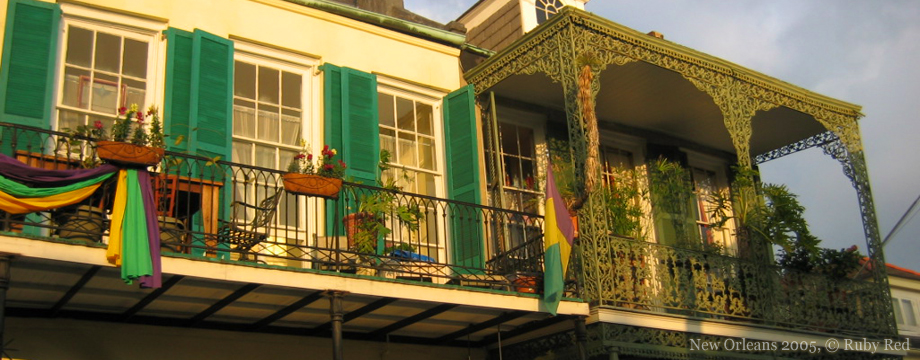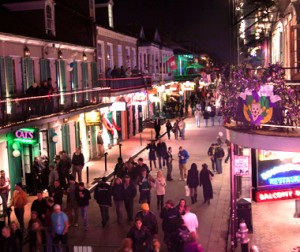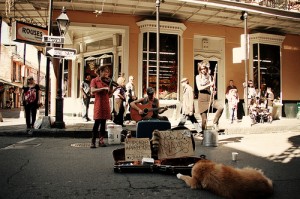We approached Bourbon Street in a circumspect manner, like pioneers skirting the edge of an overflowing river. The “drunken-steins” as my companion called them, spilled down the adjoining streets like bubbling tributaries, sometimes gurgling straight into us. We side-stepped and dodged, re-directing our own flow, forging across the stream, sometimes getting caught up. We mostly navigated side streets, looking into windows, perusing menus, observing the thousands of details that give the French Quarter its flavor—the balconies, doorknobs, shuttered first-floor windows, ornate metal work, peeling paint, hanging ferns, all of it a peculiar stylized version of an antiquated city life.
The locals have their own panache and build. They are lean and wiry, or round and somnolescent, bored by the beauty, unaffected by the scenery and skilled at avoiding the ambling tourists who wear their mediocrity in the polos and tourist shorts, the squeaky white walking shoes, the obvious cameras and baseball caps.
When we finally gave in to the tug of Bourbon Street, entering on the north end of the quarter and flowing south. Quiet shuttered houses gave way to bars illuminated with christmas lights and then flat-screen TVs. Soon the sound of party music added to the roar, but it wasn’t Dixieland, and only in one case was it Cajun. The rest of it was Jay-z, Rihanna, and maybe a touch of Three Six Mafia, or their imitators. The crowds were increasingly rowdy, meandering and threatening inadvertent violence, or worse, liquor-induced sickness. We stuck together, occasionally splitting to avoid someone who stumbled in our direction. The lights grew brighter, the mardi gras beads bigger, and the call of club hawkers, more aggressive. I angled towards a country bar, to observe a couple cowboy-hat clad patrons dancing, to be accosted by a doorman. “Come on in! Don’t just stand out there!” Repelled by his aggressive tone, I moved back towards the anonymity at the center of the street.
Bourbon street was a farce, a disney-land approximation of a party, but more obscene. On upper Decatur and Frenchman street we found actual musicians and more contemporary approximations of jazz and blues. Not the old kind. Not what you would have heard in the days of Louis or Sidney. But it was good, quality musicianship. What struck me was the stillness of the patrons. Sitting stock still in their seats, only occasionally tapping a foot or nodding a head. I felt like a prisoner in my body, wanting to reflect the rhythms. I settled for tapping my hands on my thighs, shuffling a foot in time with the kick drum. The effort of watching gave me an appreciation for the drummer, for his various contortions and graceful cascades of rhythmic flourishes. Only one patron next to me grooved along, moving his body in time to the music. We were the anomaly.
In another bar where the front-man spoke to the audience and called out the girls on the fringe who were obviously wanting to dance, there was a brief explosion of shaking and shimmying. It wasn’t beautiful or coordinated, but spirited and free. The patrons on the edge watched, quiet, sipping their beers. The few girls who had held down the dance party left and the rest of us remained seated. I had been in the corner by the wall, shuffling, tapping, hip-circling and generally enjoying myself. Dancing for me, not an audience. Yet I felt the eyes of people who did not dance upon me.
Against this particular backdrop, dance culture appears rare and stylized. The rest of America sits and watches, observing, consuming, but not participating. The few of us who dance are outside the lines, a little strange, or perhaps specially talented. It’s like music culture. Done by ‘others,’ ‘artists’ (in a whipser: homosexuals). It’s no wonder that in Julia Cameron’s book, The Artists’ Way, she spends a great deal of time undoing negative internal scripts attached to being an artist. It’s what you do if you want to be poor, destitute, cast out by society. Parents never approve. They want doctors, lawyers, businessmen. Artists are somehow failures at life, people who are unable to march in time with industry, people who can’t get up at sun-rise and who always stay out late. By extension, the musicians, dancers, painters, anyone who does these things as a hobby is bucking a cultural norm, dipping into treacherous waters.
But this is against our nature.The social pressure not to dance is stronger, only because there is so much shame and fear around who we are. We are not beautiful enough, not coordinated enough and certainly not talented enough, because to ‘have rhythm’ is somehow viewed as having a talent, and to move in a coordinated manner is somehow a skill. Never mind that the heart pumps in a rhythm, and the body naturally balances itself around a shifting axis with every step. Never mind that generations of people can move their pelvises with enough coordination to procreate, and can independently control their limbs enough to operate a vehicle while texting or smoking a cigarette. Dancing is in our bodies and the way we live, but we are cut off from it by our mental constructs around what is viewed as acceptable in a social setting.
This is why dance culture lives apart from regular culture. It’s why dancers who hire bands have to explain how to play for dancers, which is different than playing for drinkers who sit. It’s why many people I meet have never heard of Blues Dance and only think of Swing as that thing you do when you “throw the girl around” like in the old movies. It’s why those of us who do dance spend precious time and money, flying into cities to attend private gatherings to be in the company of those like us, those who move freely and without fear, regardless of our talent or skill. The fact that it is so separate from regular culture pains me. I don’t want to be the crazy lady at the party who is dancing all alone. I want all the patrons to join me in the dance.





2 Responses to On Dance Culture: Separate and Unequal